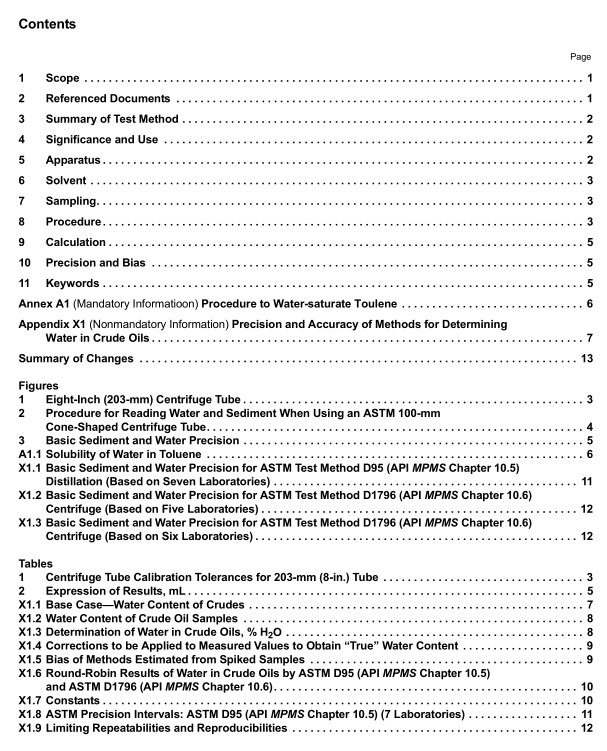API MPMS 10.3 pdf download

API MPMS 10.3 pdf download Manual of Petroleum Measurement Standards Chapter 10.3 Standard Test Method for Water and Sediment in Crude Oil by the Centrifuge Method (Laboratory Procedure)
8.3 Loosen the stoppers slightly and immerse the tubes to the 100-mL mark for at least 15 min in the bath maintained at 60 6 3°C (140 6 5°F) (see 5.3). Secure the stoppers and again invert the tubes ten times to ensure uniform mixing of oil and solvent. (Warning—The vapor pressure at 60°C (140°F) is approximately double that at 40°C (104°F).)
8.4 Place the tubes in the trunnion cups on opposite sides of the centrifuge to establish a balanced condition. (If the tubes cannot be counter-balanced by eye, place them, in their trunnion cups, on either side of a balance and equalize their masses by the addition of water to the trunnion cups.) Re- tighten the corks and spin for 10 min at a minimum relative centrifugal force of 600 calculated from the equation given in 5.1.6.
8.5 Immediately after the centrifuge comes to rest following the spin, read and record the combined volume of water and sediment at the bottom of each tube, to the nearest 0.05 mL from 0.1 to 1-mL graduations, and to the nearest 0.1-mL above 1-mL graduations. Below 0.1 mL, estimate to the nearest 0.025 mL (refer to Fig. 2). Return the tubes without agitation to the centrifuge and spin for another 10 min at the same rate.
8.6 Repeat this operation until the combined volume of water and sediment remains constant for two consecutive readings. In general, not more than two spinnings are required.
8.7 The temperature of the sample during the entire centri- fuging procedure shall be maintained at 60 6 3°C (140 6 5°F) (see 5.3).
8.8 To avoid the danger of tubes breaking in the cups, care must be taken that the tubes are bedded onto the bottom cushion so that no part of the tube is in contact with the rim of the cup.
9. Calculation
9.1 Record the final volume of water and sediment in each tube. If the difference between the two readings is greater than one subdivision on the centrifuge tube (see Table 1) or 0.025 mL for readings of 0.10 mL and below, the readings are inadmissible and the determination shall be repeated.
9.2 Express the sum of the two admissible readings as the percentage by volume of water and sediment; report the results as shown in Table 2.
10. Precision and Bias
10.1 Precision—The precision of this test method, as deter- mined by statistical examination of interlaboratory test results in the range from 0.01 to 1.0 %, is described in 10.1.1 and 10.1.2.
10.1.1 Repeatability—The difference between two test results, obtained by the same operator with the same apparatus under constant operating conditions on identical test material, would, in the long run, in the normal and correct operation of the test method, exceed the following value in only one case in twenty: From 0.0 % to 0.3 % water, see Fig. 3. From 0.3 % to 1.0 % water, repeatability is constant at 0.12.
10.1.2 Reproducibility—The difference between two single and independent test results obtained by different operators working in different laboratories on identical test material, would, in the long run, in the normal and correct operation of the test method, exceed the following value in only one case in twenty: From 0.0 % to 0.3 % water, see Fig. 3. From 0.3 % to 1.0 % water, reproducibility is constant at 0.28.
10.2 Bias—The procedure in this test method has no bias because the value ofwater and sediment can be defined only in terms of a test method. 11. Keywords 11.1 centrifuge; centrifuge tube; crude oil; laboratory pro- cedure; sampling; sediment and water; solvent









